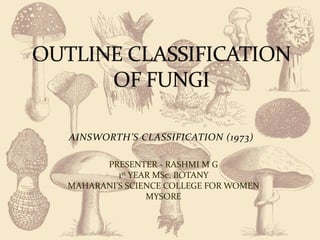
OUTLINE CLASSIFICATION OF FUNGI.pptx
- 1. AINSWORTH’S CLASSIFICATION (1973) PRESENTER - RASHMI M G 1st YEAR MSc. BOTANY MAHARANI’S SCIENCE COLLEGE FOR WOMEN MYSORE
- 2. FUNGI are eukaryotic protists without chlorophyll They have true nuclei containing several chromosomes confined in a nuclear membrane, on that basis these are separated from the prokaryotic protists(bacteria and blue green algae) which do not have nuclear membranes or other membrane bound organelles and placed in the eukaryotic protists.
- 3. They are heterotrophic, spore bearing eukaryotes They may be single-celled or multicellular Multicellular fungi are composed of networks of long filamentous, branched structure called HYPHAE Hyphae often aggregate in a dense network known as MYCELIUM Hyphae may be without cross walls( as in the case of lower fungi) or divided into compartments by formation of septa (in higher fungi)
- 4. Geoffrey Clough Ainsworth (9Oct 1905 in Birmingham-25Oct 1998 in Derby) 1. Received his doctorate in Biology from the University of London in 1934 2. He was a British mycologist and scientific historian 3. He studied and wrote on fungi including their medical uses 4. He wrote on the history of the field with- An Introduction to the History of Mycology (1976) An Introduction to the History of Plant Pathology (1981) An Introduction to the History of Medical and Veterinary Mycology (1986) In 1980 he was awarded Linnean Medal shared with Roy Crowson
- 5. KINGDOM- FUNGI (MYCETEAE) Plasmodium or pseudo plasmodium present Plasmodium or pseudo plasmodium absent, typically filamentous MYXOMYCOTA (SLIME MOLDS) EUMYCOTA OOSPORES, MOTILE SPORANGIOSPORES (ZOOSPORES) ZYGOSPORES NON MOTILE SPORANGIOSPORES (APLANOSPORES) ASCOSPORES BASIDIOSPORES SEXUAL SPORES ABSENT SUB DIVISION DIVISION MASTIGOMYCOTINA “WATER MOLDS” ZYGOMYCOTINA (CONJUGATE FUNGI) ASCOMYCOTINA (SAC FUNGI) BASIDIOMYCOTINA (CLUB FUNGI) DEUTERO MYCOTINA (IMPERFECT FUNGI) CLASS Chytridiomycetes Hypo- Chytridiomycetes Oomycetes Zygomycetes Trichomycetes Hemiascomycetes Plectomycetes Pyrenomycetes Discomycetes Laboulbeniomycetes Loculoascomycetes Teliomycetes Hymenomycetes Gasteromycetes Blastomycetes Hyphomycetes Coelomycetes
- 6. ACRASIOMYCETES EX. Dictyostelium Brain-eating amoeba Acrasidae HYDROMYXOMYCETES Ex net slime molds MYXOMYCETES Ex. Dog vomit slime mold physarum leucophaeum PLASMODIOPHOROMYCETES Plasmodiophora brassicae, which causes clubroot of cabbage and related plants, and Spongospora subterranea, which causes powdery scab of potatoes.
- 7. FUNGI is classified into 2 divisions – MYXOMYCOTA that includes the slime molds and EUMYCOTA The EUMYCOTA has been divided into 4 sub divisions ranging from aquatic motile saprophytes through the terrestrial yeasts and molds to the mushrooms The 4 subdivisions are –MASTIGOMYCOTINA, ZYGOMYCOTINA, ASCOMYCOTINA and BASIDIOMYCOTINA These subdivisions are characterized by the production of a sexual spore The form subdivision called the DEUTEROMYCOTINA (fungi imperfecti) has been established to accommodate those fungi that do not have a sexual spore, the fungi belonging to this are called “imperfect fungi”
- 8. CHARACTERS MASTIGOMYCOTINA ZYGOMYCOTINA ASCOMYCOTINA BASIDIOMYCOTINA HABITAT AQUATIC/ TERRESTRIAL TERRESTRIAL TERRESTRIAL TERRESTRIAL PLOIDY DIPLOID MONOPLOID MONOPLOID DIKARYOTIC, MONOPLOID MOTILE STAGE PRESENT ABSENT ABSENT ABSENT SEXUAL SPORE OOSPORES ZYGOSPORE ASCOSPORE BASIDIOSPORE ASEXUAL SPORE HOLOCARPIC SPORANGIOSPORES/C HLAMYDOSPORES CONIDIA ARTHROSPORES,OIDI A, CONIDIA PATHOGENIC RELATIONSHIP OBLIGATE PARASITES FACULTATIVE PARASITES FACULTATIVE/OBLIGA TE PARASITES FACULTATIVE/ OBLIGATE PARASITES EXAMPLES DOWNY MILDEW FUNGI BLACK BREAD MOLD(Rhizopus stolonifer) (Sac fungi) Neurospora crassa (Club fungi) Mushrooms, rust and smut fungi Note- blue green mold Claviceps purpurea which causes “ERGOTISM” belongs to ascomycotina Ergotism – poisoning produced by eating food affected by ergot, typically resulting in headache, vomiting, diarrhea and gangrene of the fingers and toes
- 9. MASTIGOMYCOTINA- this group are commonly called as Chytrids. These fungi produce oospores that are capable of moving on their own through a liquid medium by simple flagella This is further grouped in classes- Chytridiomycetes- ex. Allomyces, Synchytrium endobioticum(a pathogen of potato, Neocallimastix Oomycetes- ex. Pythium oligandrum ( used for biocontrol), Phytophthora infestans (late blight of potato) Neocallimastix Phytophthora infestans Pythium oligandrum Allomyces Synchytrium endobioticum
- 10. ZYGOMYCOTINA- Commonly known as conjugate fungi reproduce sexually with meiospores called zygospores and asexually with sporangiospores This are further subdivided into classes- Zygomycetes- ex. Lichtheimia corymbifera, Rhizomucor pusillus, Black bread mold Trichomycetes –ex. Choanephora cucurbitarum Choanephora cucurbitarum Rhizomucor pusillus Black bread mold Lichtheimia corymbifera
- 11. ASCOMYCOTINA – Are commonly known as sac fungi . They form meiotic spores called ascospores within a special sac like structure called an ASCUS They bear their sexual stages in fruiting bodies called ASCOCARP This division includes morels, some mushrooms and truffles as well as single- celled yeasts This group is further divided into classes- Hemiascomycetes- ex- Saccharomyces boulardii, Geotrichum candidum Plectomycetes- ex. Chrysosporium, Microsporum, Trichophyton Pyrenomycetes- ex. Neurospora crassa, Podospora anserina, Sordaria fimicola Discomycetes- ex. Swamp beacon,Coryne cylichnium,Neoboulgaria pura
- 12. Swamp beacon Trichophyton Saccharomyces boulardii Neurospora crassa Neoboulgaria pura
- 13. BASIDIOMYCOTINA- Commonly called as club fungi They produce meiospores called basidiospores on club like stalks called BASIDIA The most commonly examples of fungi belongs to this group like mushrooms, rust and smut fungi They are further subdivided into classes- Teliomycetes Hymenomycetes Gasteromycetes Rust fungi Corn smut Oyster mushroom Agaricus
- 14. DEUTEROMYCETES- They do not have sexual stage Therefore they are known as imperfect fungi They resemble ascomycetes or in few instances basidiomycetes but produce neither ascus nor basidia Examples - Alternaria, Colletotrichum and Trichoderma Alternaria solani Trichoderma harzianum colletotrichum gloeosporioides
- 15. Fungi are heterotrophy, they do not bear chlorophyll. The cell wall mainly contains chitin and glucans , ergosterol is present The food storage is in the form of glycogen There is alternation of generation The major divisions of fungi are mainly classified based on their sexual spores and sexual reproductive structures fungi is classified into myxomycota and eumycota based on the presence of Plasmodium or pseudo plasmodium Eumycota is further subdivided into subdivisions like mastigomycotina, zygomycotina, ascomycotina, basidiomycotina, deuteromycotina Reference https://www.wikipedia.org/ https://images.google.com/ Copyright 2018 by Pathfinder Publication